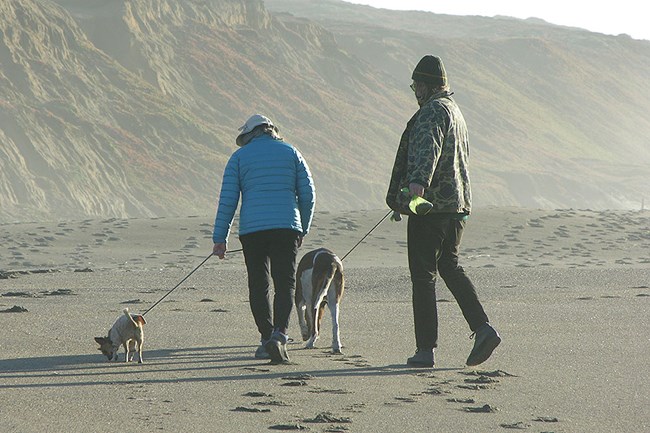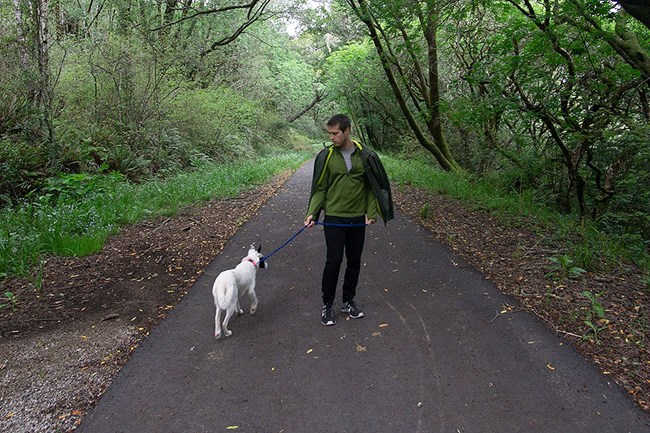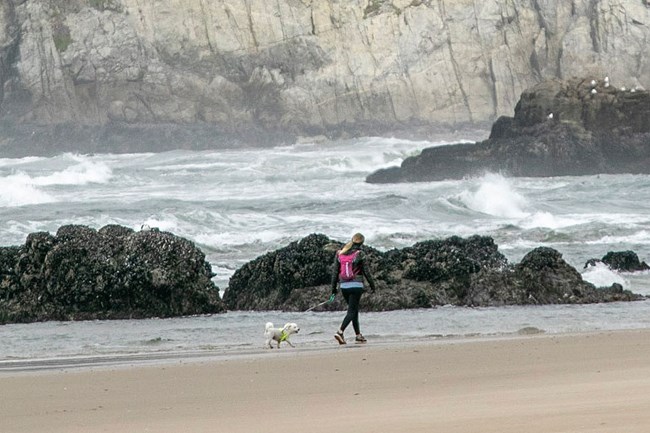
NPS Photo Enjoying Point Reyes with Your PetLeashed pets are welcome at Point Reyes on sections of specific beaches and trails and in a few areas. Visiting a National Park with a pet poses unique challenges. Please take a moment to review these guidelines to keep your pet, visitors, and wildlife safe. Pet owners are responsible for knowing park rules and regulations. Those not adhering to the regulations will be cited. Locations Where Pets are PermittedPets are allowed in parking lots, along public roads, and along with the trails and beaches described below. All other trails, beaches, and off-trail lands within Point Reyes National Seashore and the Northern District of Golden Gate National Recreation Area are closed to the possession of pets. Always keep your pets on a leash. 
NPS / Anela Kopshever. TrailsWarning: Many of these trails pass through cattle pasture. Please Note: Sections of the trails listed below may temporarily be closed to dogs due to unexpected circumstances. Please check our Current Conditions page for information about temporary closures of the following trails. Within Point Reyes National SeashorePets are permitted on:
All other trails within Point Reyes National Seashore are closed to pets. Within the Northern District of Golden Gate National Recreation AreaPets are permitted on the :
* Please note that the Tomales Bay Trail on the east side of Tomales Bay is not the same as the Tomales Point Trail at the north end of the Point Reyes Peninsula. Pets are not permitted on the Tomales Point Trail. Download a map showing the trails within the Northern District of Golden Gate National Recreation Area where pets are permitted. (4,592 KB PDF) 
NPS / Anela Kopshever. BeachesPlease Note: Sections of the beaches listed below may temporarily be closed to dogs due to unexpected circumstances. Please check our Current Conditions page for information about temporary closures of the following beaches. Ocean-facing BeachesPets are allowed on the following ocean-facing beaches throughout the year:
Download a map showing the ocean-facing beaches within Point Reyes National Seashore where pets are permitted throughout the year. (3,197 KB PDF) Tomales Bay BeachesAs of May 30, 2023, pets are no longer permitted on National Seashore beaches on the west side of Tomales Bay. In addition to the National Seashore beaches on the west side of Tomales Bay, pets are not permitted on:
Maps showing locations where pets are usually permitted year-round*:Full park map (8,316 KB PDF) * Notice: Sections of the beaches or trails highlighted in the above maps may temporarily be closed to dogs due to unexpected circumstances. Please check our Current Conditions page for information about temporary closures of the highlighted beaches and trails.
Become a Point Reyes BARK RangerCollect and dispose of all animal waste in a proper waste receptacles. Pet waste can pass diseases to park wildlife. Water sources may be impacted by pet feces. Pets must be on a leash no longer than 6 feet (1.8 meters) at all times. Leashes protect your pets and wildlife. Wildlife can harm your pets, and off-leash dogs have injured and killed wildlife. Pets can chase and threaten wildlife, scaring birds and other animals away from their nesting, feeding, and resting sites. Please keep your distance from any birds roosting on beaches. Listed above are the beaches and trails where pets are welcome. Never leave a pet unattended in the car. Additional InformationWorking service dogs may accompany their owners to all park locations and programs. If you have a service dog, please inquire at a park visitor center for information before setting out. Please note: Only dogs are classified as service animals, and they must perform a specific task that assists a person with a disability. Emotional support or comfort animals are not service animals. If you bring a dog, or any other pet, to the park, please observe the following regulations:
Code of Federal Regulations Title 36 Chapter 1 Section 2.15 provides more details concerning pets within National Park Service sites.) Dogs and other pets are wonderful animals that give comfort and companionship. However, a national park is not the best place for them.
Bolinas Ridge Trail, Jewell Trail, McCurdy Trail, and Randall Trail within Golden Gate National Recreation Area and the trails and roads within the Niman Ranch/Commonweal area pass through cattle pasture. Cattle can feel threatened by dogs, which they may perceive to be a predator. Mother cows may become aggressive when trying to protect their young. Please read Understanding Working Rangelands: Sharing Open Space: What to Expect from Grazing Livestock (1,314 KB PDF) to better understand basic cattle behavior and to give yourself a better chance to predict how cattle are likely to react to your dog's presence. This will help make your hike along these trails safer and more enjoyable. |
An official website of the United States government
Here's how you know
Official websites use .gov
A
.gov website belongs to an official government
organization in the United States.
Secure .gov websites use HTTPS
A
lock (
) or https:// means you've safely connected to
the .gov website. Share sensitive information only on official,
secure websites.
